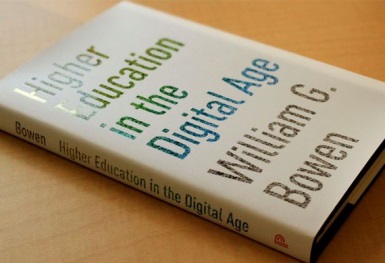HETL Note: We are pleased to present our next installment in the International HETL Review (IHR) book review series. The book review provides a detailed examination of William G. Bowen’s book titled “Higher Education in the Digital Age” and adds a scholarly commentary to complement the author’s ideas. Linda S. Watts highlights the key issues raised by Bowen, most importantly the role of and impact of technology in general and specifically online learning on education and educational systems alike. The review navigates through Bowen’s book, maps the important points and gives additional support to some of them by referring to current developments – leaving it to the reader to enjoy reading the book itself and draw their own conclusions.
 Author Bio: Linda S. Watts is Professor of American Studies in the School of Interdisciplinary Arts and Sciences at the University of Washington, Bothell (UWB), where she serves as a point-of-contact for faculty and academic staff exploring assessment of student learning. Prior administrative positions include Education Program Director (UWB), Interdisciplinary Arts and Sciences Program Director (UWB), Associate Dean of the College of Arts and Sciences, and Women’s Studies Program Associate Director (both at Drake University, USA.). Her teaching and research interests include 19th- and 20th-century United States literature and culture; visual art practice, production, and exhibition; women’s studies; multicultural education and curriculum revision; critical and alternative pedagogy; institutional change and educational leadership. Professor Watts can be contacted at [email protected]
Author Bio: Linda S. Watts is Professor of American Studies in the School of Interdisciplinary Arts and Sciences at the University of Washington, Bothell (UWB), where she serves as a point-of-contact for faculty and academic staff exploring assessment of student learning. Prior administrative positions include Education Program Director (UWB), Interdisciplinary Arts and Sciences Program Director (UWB), Associate Dean of the College of Arts and Sciences, and Women’s Studies Program Associate Director (both at Drake University, USA.). Her teaching and research interests include 19th- and 20th-century United States literature and culture; visual art practice, production, and exhibition; women’s studies; multicultural education and curriculum revision; critical and alternative pedagogy; institutional change and educational leadership. Professor Watts can be contacted at [email protected]
Krassie Petrova and Patrick Blessinger
~~~~~~~~~~~~~~~~~~~~~~~~~
Review of William G. Bowen’s “Higher Education in the Digital Age” (2013, Princeton University Press)
Linda S. Watts
University of Washington, Bothell, U.S.A.
 The format of this book is an engaging one, especially insofar as it approximates the experience of a conversation among distinguished thinkers. Bowen’s 2012 Tanner lectures, “Cost and Productivity in Higher Education” and “Prospects for an Online Fix,” serve as centerpieces in this exchange of ideas. Along with these texts, Higher Education in the Digital Age features responses from a series of notable educators, each positioned to address key aspects of such a discussion: Howard Gardner (John H. and Elisabeth A. Hobbs Professor of Cognition and Education at Harvard University and Senior Director of Harvard Project Zero), John L. Hennessy (Stanford University president), Andrew Delbanco (Mendelson Family Chair of American Studies and Julian Clarence Levi Professor in the Humanities, Columbia University), and Daphne Koller (Rajeev Motwani Professor of Computer Science, Stanford University, and cofounder of the online learning environment Coursera). Bowen also offers replies to these commentaries, completing the volume’s structure. This approach has the effect of satisfying an academic’s appetite for debate, especially on topics so controversial.
The format of this book is an engaging one, especially insofar as it approximates the experience of a conversation among distinguished thinkers. Bowen’s 2012 Tanner lectures, “Cost and Productivity in Higher Education” and “Prospects for an Online Fix,” serve as centerpieces in this exchange of ideas. Along with these texts, Higher Education in the Digital Age features responses from a series of notable educators, each positioned to address key aspects of such a discussion: Howard Gardner (John H. and Elisabeth A. Hobbs Professor of Cognition and Education at Harvard University and Senior Director of Harvard Project Zero), John L. Hennessy (Stanford University president), Andrew Delbanco (Mendelson Family Chair of American Studies and Julian Clarence Levi Professor in the Humanities, Columbia University), and Daphne Koller (Rajeev Motwani Professor of Computer Science, Stanford University, and cofounder of the online learning environment Coursera). Bowen also offers replies to these commentaries, completing the volume’s structure. This approach has the effect of satisfying an academic’s appetite for debate, especially on topics so controversial.
The book’s configuration affords another advantage. One of the most striking features of discourse in (and about) higher education is the extent to which importantly integral issues too frequently receive discussion in isolation. Bowen’s lean volume [172 pp.] is, on one level, an attempt to bridge two conversations that have achieved little lasting contact: the dilemma of funding in higher education and the prospect/problem of online education.
While these two discourses (about higher education cost and technological innovation) are vital considerations for higher education world-wide, the cost conundrum may be especially crucial within the United States, where median family income has failed to keep pace with rising tuition costs. In fact, Bowen cites 2012 Federal Reserve Bank of New York’s Household Debt and Credit Report data that indicates that starting in 2009, student debt outstripped credit card debt (p. 21). This sharp trend continues, with the 2012 figure for student debt ($914 billion) far exceeding credit card debt ($672 billion).
As President Emeritus of Princeton University (1972-1988) and the Andrew W. Mellon Foundation (1998-2006), William G. Bowen speaks about current issues in higher education with the voice of experience, often enough gained through experience. Having moved from the posture of an information technology skeptic to a “convert” (p. 45), Bowen admits to being neither novice nor expert in educational technology. What he has to say provides stimulating and valuable insights suggestive of deep intelligence and wise reflection, qualities often slighted in the rush to technological innovation.
It might be easy—and tempting—to publish a book that argues squarely “for” or “against” technology and online learning as the cures to the fiscal crisis in higher education in the United States. To his credit, Bowen asks more, both of himself and his audience. He understands that institutional vitality is never strictly a technical matter, but also involves conceptual, organization, and administrative transformation. Instead, Bowen poses difficult questions about what he terms the “cost disease” in higher education; he also admits that he is still grappling with answers to these questions as he writes. (p. ix) His message about the resource question is as timely as it is blunt: “We must recognize that if higher education does not begin to slow the rate of increase in college costs, our nation’s higher education system will lose the public support on which it so heavily depends.” (p. 62)
It might also be a straightforward task to release a book that performs a simple cost analysis of higher education, urging educational leaders to mind the bottom line. As would be predictable in someone who emerged as a scholar in labor economics, Bowen is at his most authoritative when discussing the problems of productivity, cost, and affordability in higher education. A careful study of his lectures and their informative endnotes goes a long way toward educating the reader about the realities of financing higher education in the United States, although the size and scope of the text does not allow for consideration of alternative funding models such as the U.S.A. State of Oregon’s ‘Pay Forward, Pay Back’ pilot program where students do not have to pay tuition fees rather they undertake to pay back by contributing to the state a relatively small portion of their future income. Still, Bowen does not yield to the impulse to recommend a formulaic remedy to the cost problem facing today’s U.S.A. colleges and universities; such recommendations tend to be about as helpful as the stock tip to “buy low, sell high” (lower tuition cost, raise retention, lower time-to-degree, raise completion rate, and so forth). If higher education produces a public good as well as a market good, it is not measured in enrollments achieved and degrees conferred alone, but as importantly in lives transformed and improvements to the lived world. According to Bowen, no mere head count or completion rate suffices; rather, an understanding of quality (emphasis added) education must inform and accompany any claims to increased productivity in higher education.
What is most impressive, however, about Bowen’s perspective is that he explores the perils and possibilities of online learning in the context of institutional “core values.” Cost savings or technological advances must be considered in relation to a college or university’s central mission and goals. Which courses of action best align with the standard of teaching and learning that is the signature of a given institution of higher education? It takes courage to confront the tensions between cost-savings measures on one hand and integrity measures on the other. Moreover, it will require rigor and ingenuity to demonstrate through valid data the results of machine-guided learning, both financially and educationally. For example, Bowen contends that, “There is a real danger that the media frenzy associated with MOOCS will lead some colleges and universities (and, especially, business-oriented members of their boards) to embrace too tightly the MOOC approach before it is adequately tested and found to be both sustainable and capable of delivering good learning outcomes for all kinds of students.” (p. 70).
Bowen advocates cautious strategies for navigating institutional change, namely a portfolio approach to curricular development (attentive to differences in instructional methods, fields, and modes) and controlled randomized trials to document the results of such practices as MOOCS or hybrid courses. Along the way, he underscores the complexity in envisioning a model of higher education that is both more effective and more efficient.
Bowen resists the notion of technology as, in itself, remedy to the problems of cost and productivity in higher education, and states that online education is not automatically cheaper than face-to-face instruction once all the many variables are considered. It does, however, offer one promising area for innovation regarding the affordability and accountability of higher education. Bowen asserts that, “Far greater access to the Internet, improvements in Internet speed, reductions in storage costs, the proliferation of increasingly sophisticated mobile devices, and other advances have combined with changing mindsets to suggest that online learning, in many of its manifestations, can lead to at least comparable learning outcomes relative to face-to-face instruction at lower cost.” (p. 45) Online instruction is not necessarily more–or less– reliable in terms of student learning outcomes. In fact, Bowen makes the point that we have a long way to go before our empirical assessment data regarding student learning in online environments can argue rigorously for its standing in relation to more traditional settings in higher education such as the classroom, workshop, or institute.
There are tough choices ahead in higher education, and we all try to address them forthrightly and candidly. The efficacy of such decisions relies upon our capacity to select pathways to futures we wish to inhabit, ones that are consonant with an institution’s larger purpose. Howard Gardner captures this distinction succinctly with an anecdote. Witness his reply to a student who asked why he needs school at all if his smartphone already holds all the answers: “Yes, the answer to all questions—except the important ones.” (p. 106)
This book review was prepared for publication by Tina Bass (Coventry University, UK), Associate Senior Editor, International HETL Review.
Suggested Citation
Watts, L. S. (2013). Review of William G. Bowen’s “Higher Education in the Digital Age”. The International HETL Review. Volume 3, Article 11, https://www.hetl.org/book-review-articles/review-of-william-g-bowens-higher-education-in-the-digital-age
Copyright © [2013] Linda S. Watts
The author(s) assert their right to be named as the sole author(s) of this article and the right to be granted copyright privileges related to the article without infringing on any third-party rights including copyright. The author(s) retain their intellectual property rights related to the article. The author(s) assign to HETL Portal and to educational non-profit institutions a non-exclusive license to use this article for personal use and in courses of instruction provided that the article is used in full and this copyright statement is reproduced. The author(s) also grant a non-exclusive license to HETL Portal to publish this article in full on the World Wide Web (prime sites and mirrors) and in electronic and/or printed form within the HETL Review. Any other usage is prohibited without the express permission of the author(s).
Disclaimer
Opinions expressed in this article are those of the author, and as such do not necessarily represent the position(s) of other professionals or any institutions




